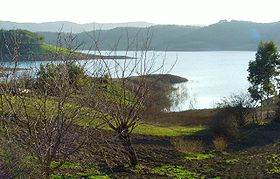Seyhan River
36°59′18″N 35°20′5″E / 36.98833°N 35.33472°E
| Seyhan Sarus | |
|---|---|
 Seyhan River flowing through Adana | |
 | |
| Native name |
|
| Location | |
| Country | Turkey |
| Provinces | Kayseri, Adana, Mersin |
| Districts | Aladağ, Karaisalı, Çukurova, Sarıçam, Seyhan, Yüreğir, Tarsus |
| Towns/Cities | Adana, ancient Augusta |
| Physical characteristics | |
| Source | Akinek Dağı |
| • location | Aladağ, Adana, Turkey |
| • elevation | 1,500 m (4,900 ft) |
Zamantı | |
The Seyhan River (formerly written Seihan, Sihun; ancient name:
Its sources were reported being in the Taurus Mountains in Cataonia. It flowed through Cappadocia by the town of Comana, then through Cilicia. It is noted by numerous ancient authors including Livy,[3] Xenophon,[4] Procopius,[5] Strabo,[6] Ptolemy,[7] Appian,[8] Pliny the Elder,[9] and Eustathius of Thessalonica who erroneously calls it Sinarus.[10]
50 km from its mouth, Seyhan River flows through the city of Adana, the only settlement situated on the river. Several bridges and footbridges cross the river in Adana including the Stone Bridge, a 2nd-century Roman bridge. Ancient city of Augusta was also situated on the river, corresponding today to the east side of the Çatalan reservoir. The river meets the Mediterranean Sea at Cape Deli.
History

An ancient Greco-Roman legend mentions that the name of the city of Adana originates from Adanus, the son of the Greek god Uranus, who founded the city next to the river with his brother. His brother's name, Sarus, was given to the river.[11]
Originally, the River Sarus flowed from the mountains,[12] became the Seyhan River whilst passing through Cilicia and then onwards to the Mediterranean Sea.[2]
In 2009, a total of 33 fish species were listed as being found in the Seyhan River, including 29 native, 3 introduced and 4 endemic species. Eight amphibians were listed and two of them (
The major
See also
References
- ^ ISBN 9780081026120.
- ^ a b John Garstang and O.R. Gurney The Geography of the Hittite Empire (1959), p. 51, at Google Books
- Ab urbe condita Libri[History of Rome]. Vol. 33.41.
- ^ Xenophon, Anabasis 1.4.1.
- ^ Procopius, de Aedif. 5.4.
- ^ Strabo. Geographica. Vol. xii. p. 535. Page numbers refer to those of Isaac Casaubon's edition.
- ^ Ptolemy. The Geography. Vol. 5.8.4.
- ^ Appian Syr. 4.
- ^ Pliny. Naturalis Historia. Vol. 6.3.
- ^ Eustathius of Thessalonica, ad Dion. Per. 867.
- ^ Anton, Charles (1841). Classical Dictionary: Containing an account of the principal proper names mentioned in ancient authors... New York: Harper & Brothers.
- ^ Charles Pye A New Dictionary of Ancient Geography, exhibiting the modern in addition to the Ancient Names of places (1803), p. 299, at Google Books
- ^ "Cumulative Impact Assessment Baseline Monitoring Report for the Goksu-Seyhan Hydropower Cascade" (PDF). EnerjiSA. February 2011. Retrieved 31 May 2013.
![]() This article incorporates text from a publication now in the public domain: Smith, William, ed. (1854–1857). "Sarus". Dictionary of Greek and Roman Geography. London: John Murray.
This article incorporates text from a publication now in the public domain: Smith, William, ed. (1854–1857). "Sarus". Dictionary of Greek and Roman Geography. London: John Murray.
External links
